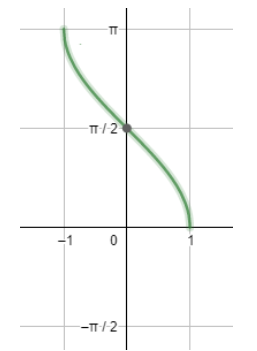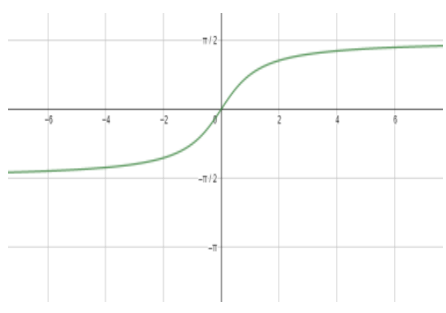
Write the value of ${{\tan }^{-1}}\sqrt{3}-{{\sec }^{-1}}\left( -2 \right)$ .
Answer
581.1k+ views
Hint: The above question is related to inverse trigonometric function and for solving the problem, you just have to put the values of ${{\sec }^{-1}}\left( -2 \right)\text{ and }ta{{n}^{-1}}\sqrt{3}$ and solve the expression by finding the difference between them. Remember for finding the value of ${{\sec }^{-1}}\left( -2 \right)$ , you will have to use the property that ${{\sec }^{-1}}\left( -x \right)=\pi -{{\sec }^{-1}}x$ .
Complete step-by-step answer:
Before starting with the solution to the above question, we will first talk about the required details of different inverse trigonometric ratios. So, we must remember that inverse trigonometric ratios are completely different from trigonometric ratios and have many constraints related to their range and domain. So, to understand these constraints and the behaviour of inverse trigonometric functions, let us look at some of the important graphs. First, let us see the graph of ${{\sin }^{-1}}x$ .

Now let us draw the graph of $co{{s}^{-1}}x$ .

Also, we will draw the graph of ${{\tan }^{-1}}x$ as well.

So, looking at the above graphs, we can draw the conclusion that ${{\tan }^{-1}}x$ is defined for all real values of x, i.e., the domain of the function ${{\tan }^{-1}}x$ is all real numbers while its range comes out to be $\left( -\dfrac{\pi }{2},\dfrac{\pi }{2} \right)$ . Unlike ${{\tan }^{-1}}x$ the functions $si{{n}^{-1}}x\text{ and co}{{\text{s}}^{-1}}x$ have the is defined only for $x\in [-1,1]$ .
Now moving to the solution to the above question, we will start with the simplification of the expression given in the question.
${{\tan }^{-1}}\sqrt{3}-{{\sec }^{-1}}\left( -2 \right)$
We know that ${{\sec }^{-1}}\left( -x \right)=\pi -{{\sec }^{-1}}x$ , and $-2$ also lies in the domain of ${{\sec }^{-1}}x$ . So, using this value in our expression, we get
${{\tan }^{-1}}\sqrt{3}-\left( \pi -{{\sec }^{-1}}2 \right)$
We also know that $ta{{n}^{-1}}\sqrt{3}=\dfrac{\pi }{3}$ and ${{\sec }^{-1}}2=\dfrac{\pi }{3}$ , and $\sqrt{3}$ also lies in the domain of $ta{{n}^{-1}}x$ . So, using this value in our expression, we get
$\dfrac{\pi }{3}-\left( \pi -\dfrac{\pi }{3} \right)=\dfrac{\pi }{3}-\dfrac{2\pi }{3}=-\dfrac{\pi }{3}$
Therefore, the value of ${{\tan }^{-1}}\sqrt{3}-{{\sec }^{-1}}\left( -2 \right)$ is equal to $-\dfrac{\pi }{3}$ .
Note: Be careful about the range and domain of different trigonometric inverse functions as they are very confusing and may lead to errors. Don’t miss the final negative sign while reporting the answer. It is also important that you learn the trigonometric table which is as follow:

Complete step-by-step answer:
Before starting with the solution to the above question, we will first talk about the required details of different inverse trigonometric ratios. So, we must remember that inverse trigonometric ratios are completely different from trigonometric ratios and have many constraints related to their range and domain. So, to understand these constraints and the behaviour of inverse trigonometric functions, let us look at some of the important graphs. First, let us see the graph of ${{\sin }^{-1}}x$ .

Now let us draw the graph of $co{{s}^{-1}}x$ .

Also, we will draw the graph of ${{\tan }^{-1}}x$ as well.

So, looking at the above graphs, we can draw the conclusion that ${{\tan }^{-1}}x$ is defined for all real values of x, i.e., the domain of the function ${{\tan }^{-1}}x$ is all real numbers while its range comes out to be $\left( -\dfrac{\pi }{2},\dfrac{\pi }{2} \right)$ . Unlike ${{\tan }^{-1}}x$ the functions $si{{n}^{-1}}x\text{ and co}{{\text{s}}^{-1}}x$ have the is defined only for $x\in [-1,1]$ .
Now moving to the solution to the above question, we will start with the simplification of the expression given in the question.
${{\tan }^{-1}}\sqrt{3}-{{\sec }^{-1}}\left( -2 \right)$
We know that ${{\sec }^{-1}}\left( -x \right)=\pi -{{\sec }^{-1}}x$ , and $-2$ also lies in the domain of ${{\sec }^{-1}}x$ . So, using this value in our expression, we get
${{\tan }^{-1}}\sqrt{3}-\left( \pi -{{\sec }^{-1}}2 \right)$
We also know that $ta{{n}^{-1}}\sqrt{3}=\dfrac{\pi }{3}$ and ${{\sec }^{-1}}2=\dfrac{\pi }{3}$ , and $\sqrt{3}$ also lies in the domain of $ta{{n}^{-1}}x$ . So, using this value in our expression, we get
$\dfrac{\pi }{3}-\left( \pi -\dfrac{\pi }{3} \right)=\dfrac{\pi }{3}-\dfrac{2\pi }{3}=-\dfrac{\pi }{3}$
Therefore, the value of ${{\tan }^{-1}}\sqrt{3}-{{\sec }^{-1}}\left( -2 \right)$ is equal to $-\dfrac{\pi }{3}$ .
Note: Be careful about the range and domain of different trigonometric inverse functions as they are very confusing and may lead to errors. Don’t miss the final negative sign while reporting the answer. It is also important that you learn the trigonometric table which is as follow:

Recently Updated Pages
Basicity of sulphurous acid and sulphuric acid are

Master Class 12 Business Studies: Engaging Questions & Answers for Success

Master Class 12 Economics: Engaging Questions & Answers for Success

Master Class 12 English: Engaging Questions & Answers for Success

Master Class 12 Maths: Engaging Questions & Answers for Success

Master Class 12 Social Science: Engaging Questions & Answers for Success

Trending doubts
What are the major means of transport Explain each class 12 social science CBSE

Which are the Top 10 Largest Countries of the World?

Draw a labelled sketch of the human eye class 12 physics CBSE

How much time does it take to bleed after eating p class 12 biology CBSE

Explain sex determination in humans with line diag class 12 biology CBSE

Differentiate between homogeneous and heterogeneous class 12 chemistry CBSE




